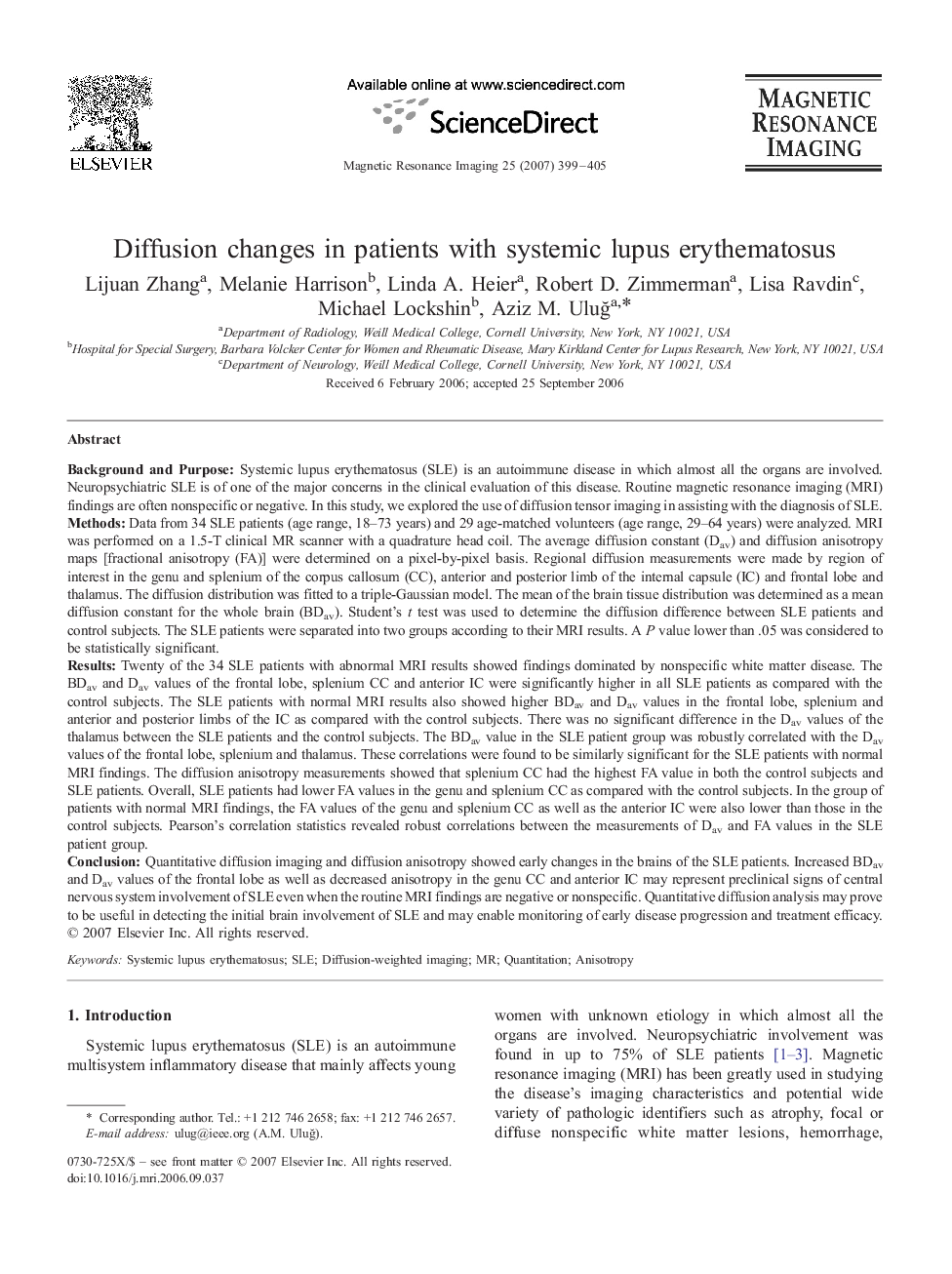| کد مقاله | کد نشریه | سال انتشار | مقاله انگلیسی | نسخه تمام متن |
|---|---|---|---|---|
| 1807912 | 1025292 | 2007 | 7 صفحه PDF | دانلود رایگان |

Background and PurposeSystemic lupus erythematosus (SLE) is an autoimmune disease in which almost all the organs are involved. Neuropsychiatric SLE is of one of the major concerns in the clinical evaluation of this disease. Routine magnetic resonance imaging (MRI) findings are often nonspecific or negative. In this study, we explored the use of diffusion tensor imaging in assisting with the diagnosis of SLE.MethodsData from 34 SLE patients (age range, 18–73 years) and 29 age-matched volunteers (age range, 29–64 years) were analyzed. MRI was performed on a 1.5-T clinical MR scanner with a quadrature head coil. The average diffusion constant (Dav) and diffusion anisotropy maps [fractional anisotropy (FA)] were determined on a pixel-by-pixel basis. Regional diffusion measurements were made by region of interest in the genu and splenium of the corpus callosum (CC), anterior and posterior limb of the internal capsule (IC) and frontal lobe and thalamus. The diffusion distribution was fitted to a triple-Gaussian model. The mean of the brain tissue distribution was determined as a mean diffusion constant for the whole brain (BDav). Student's t test was used to determine the diffusion difference between SLE patients and control subjects. The SLE patients were separated into two groups according to their MRI results. A P value lower than .05 was considered to be statistically significant.ResultsTwenty of the 34 SLE patients with abnormal MRI results showed findings dominated by nonspecific white matter disease. The BDav and Dav values of the frontal lobe, splenium CC and anterior IC were significantly higher in all SLE patients as compared with the control subjects. The SLE patients with normal MRI results also showed higher BDav and Dav values in the frontal lobe, splenium and anterior and posterior limbs of the IC as compared with the control subjects. There was no significant difference in the Dav values of the thalamus between the SLE patients and the control subjects. The BDav value in the SLE patient group was robustly correlated with the Dav values of the frontal lobe, splenium and thalamus. These correlations were found to be similarly significant for the SLE patients with normal MRI findings. The diffusion anisotropy measurements showed that splenium CC had the highest FA value in both the control subjects and SLE patients. Overall, SLE patients had lower FA values in the genu and splenium CC as compared with the control subjects. In the group of patients with normal MRI findings, the FA values of the genu and splenium CC as well as the anterior IC were also lower than those in the control subjects. Pearson's correlation statistics revealed robust correlations between the measurements of Dav and FA values in the SLE patient group.ConclusionQuantitative diffusion imaging and diffusion anisotropy showed early changes in the brains of the SLE patients. Increased BDav and Dav values of the frontal lobe as well as decreased anisotropy in the genu CC and anterior IC may represent preclinical signs of central nervous system involvement of SLE even when the routine MRI findings are negative or nonspecific. Quantitative diffusion analysis may prove to be useful in detecting the initial brain involvement of SLE and may enable monitoring of early disease progression and treatment efficacy.
Journal: Magnetic Resonance Imaging - Volume 25, Issue 3, April 2007, Pages 399–405